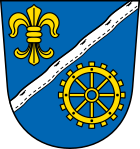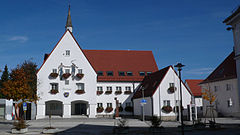Voehringen (Iller)
| coat of arms | Germany map | |
|---|---|---|

|
Coordinates: 48 ° 17 ' N , 10 ° 5' E |
|
| Basic data | ||
| State : | Bavaria | |
| Administrative region : | Swabia | |
| County : | New Ulm | |
| Height : | 499 m above sea level NHN | |
| Area : | 23.69 km 2 | |
| Residents: | 13,630 (Dec. 31, 2019) | |
| Population density : | 575 inhabitants per km 2 | |
| Postal code : | 89269 | |
| Primaries : | 07306, 07307 | |
| License plate : | NU, ILL | |
| Community key : | 09 7 75 162 | |
| City structure: | 5 parts of the community | |
City administration address : |
Hettstedter Platz 1 89269 Vöhringen |
|
| Website : | ||
| Mayor : | Michael Neher ( CSU ) | |
| Location of the city of Vöhringen in the Neu-Ulm district | ||
Vöhringen is a town in the Bavarian-Swabian district of Neu-Ulm .
geography
location
The city of Vöhringen is about 18 kilometers south of Ulm and 40 kilometers north of Memmingen an der Iller . From a regional planning point of view, it belongs to the Danube-Iller region and naturally Central Swabia .
Neighboring communities
Vöhringen borders the city of Senden in the north, the city of Weißenhorn in the east, the municipality of Bellenberg in the south and the municipality of Illerrieden in Baden-Württemberg in the west .
City structure
The municipality has 5 officially named municipal parts (the type of place is given in brackets ):
- Illerberg ( parish village )
- Illerzell ( Kirchdorf )
- Riedhof ( wasteland )
- Thal ( village )
- Vöhringen (main town)
history
Until the 19th century
Vöhringen should already be in 5./6. It originated in the 19th century when the Alemanni settled the river valleys from the Danube. "Veringen", as it appeared by name several times in the 12th century, changed hands several times in the 15th century and finally became Bavarian earlier than the neighboring towns in 1756 by Elector Max Joseph of Bavaria.
The decisive turning point for Vöhringen began in 1864 under the sign of industrialization, when the factory owner Philipp Jakob Wieland bought the local mill estate with factory premises and the associated water power. Even today, the Wieland-Werke characterize the Vöhringen townscape as a global company.
city
Vöhringen and its districts of Illerberg, Illerzell and Thal, which were already incorporated at that time, were raised to the status of town on June 25, 1977.
Incorporations
Illerzell
The formerly independent community of Illerzell with over 1300 inhabitants is located around three kilometers northwest of Vöhringen in the Illertal Valley. It was incorporated into Vöhringen on July 1, 1972.
Illerberg and Thal
Illerberg with over 1700 and Thal with around 600 inhabitants are about two kilometers east of Vöhringen and are still characterized by agriculture in their village centers. Over the decades they have grown together to form one settlement unit. Illerberg has a direct motorway connection to the A 7 Würzburg – Kempten. The formerly independent communities of Illerberg and Thal were merged on October 1, 1970 and incorporated into Vöhringen on January 1, 1976.
Population development
Between 1988 and 2019, the city grew from 12,266 to 13,630 by 1,364 inhabitants or 11.1%.
politics
City council
The city council, the composition of which is re-elected every six years, consists of 24 voluntary citizens. The last election was on March 15, 2020 . The distribution of seats can be seen in the diagram opposite and in the bottom line of the following table, which also shows the distribution of seats after previous elections.
| CSU | SPD | Green | FWG | independent | total | |
| 2002 | 10 | 7th | 1 | 4th | 1 | 24 seats |
| 2008 | 10 | 7th | 1 | 6th | 0 | 24 seats |
| 2014 | 10 | 8th | 0 | 6th | 0 | 24 seats |
| 2020 | 10 | 6th | 4th | 4th | 0 | 24 seats |
Mayor since the city was raised
- 1976 to 1996: Erich Josef Geßner (CSU)
- 1996 to 2020: Karl Janson (independent)
- Since 2020: Michael Neher (CSU)
First Mayor Michael Neher was elected in the 2020 local elections without competitors with 92.5% of the valid votes. The turnout was 45.1%.
coat of arms
Blazon of the coat of arms adopted in 1977 when the city was raised: In blue, a silver sloping bar pointing to the left; above a golden heraldic lily, below a golden mill wheel.
Town twinning
- Hettstedt in Saxony-Anhalt , since 1990
- Vizille in the Auvergne-Rhône-Alpes region ( France ), since 2002
- Venaria Reale in Piedmont ( Italy ), since 2011
Culture, clubs, sights
Cultural center
The Wolfgang-Eychmüller-Haus cultural center, which was opened in 1993 and named after the honorary citizen of the city of Vöhringen and former chairman of the board of Wieland-Werke AG, forms the social and cultural center of the city and the surrounding area. The premises are used actively and in a variety of ways by clubs, associations and artists and cultural workers of all kinds. The large hall with its around 600 seats offers a sophisticated forum for numerous events such as conferences, concerts and theater performances, but also weddings and the like.
Architectural monuments
Sports
The largest club in town is the Sportclub Vöhringen 1893 e. V. with approx. 3,000 members, spread over 19 departments.
The sports club (SV) Illerzell 1929 e. V. is the largest association in this district with 550 members. In addition to football, the SVI offers many opportunities to do sports.
The Spiel- und Sportverein (SSV) Illerberg / Thal 1948 e. V. consists of the football, gymnastics, skiing, tennis and bowling departments. "Alle Neune Thal", the sport bowling department of the SSV, is the bowling club with the largest number of members in the region.
Economy and Infrastructure
traffic
Vöhringen has a connection to the A 7 Ulm - Memmingen . The part of the B 19 Ulm – Memmingen – Kempten, which has been downgraded to a state road, is meanwhile being run past the city as a bypass road. There is also a train station on the main line between Ulm and Oberstdorf (Illertalbahn).
Vöhringen is located on the Iller cycle path , a long-distance connection for cyclists along the river from Ulm to Oberstdorf .
energy
There is an important 380 kV / 220 kV / 110 kV substation south of Vöhringen. This system also includes a 96-meter-high radio tower made of reinforced concrete.
Established businesses
- Wieland works
- Schwegler (carbide processing)
- Sheet metal & technology (sheet metal processing)
education
The city of Vöhringen with its associated districts has two primary schools, a middle school and a high school as well as a grammar school. Various courses are also offered by the adult education center and a music school is also available.
- Elementary school Illerberg
- Elementary school north
- Primary school south
- Uli Wieland Middle School
- State secondary school
- Illertal high school

sons and daughters of the town
- Charles August Fey (born February 2, 1862 in Vöhringen as Augustinus Josephus Fey, † November 10, 1944 in San Francisco), inventor of the one -armed bandit
- Solanus Hermann (born May 19, 1909 in Thal as Rudolf Hermann, † December 13, 1950 in North Korean camp detention), Benedictine monk in Tokwon Abbey
- Max Schmidt (1925–2002), chemist and university professor
- Josef Guter (* 1929), sinologist and book author
- Elmar Stegmann (* 1935), former table tennis player
Web links
- Entry on the coat of arms of Vöhringen (Iller) in the database of the House of Bavarian History
Individual evidence
- ↑ "Data 2" sheet, Statistical Report A1200C 202041 Population of the municipalities, districts and administrative districts 1st quarter 2020 (population based on the 2011 census) ( help ).
- ^ Community of Vöhringen (Iller) in the local database of the Bavarian State Library Online . Bavarian State Library, accessed on August 21, 2019.
- ↑ a b Federal Statistical Office (ed.): Historical municipality register for the Federal Republic of Germany. Name, border and key number changes in municipalities, counties and administrative districts from May 27, 1970 to December 31, 1982 . W. Kohlhammer, Stuttgart / Mainz 1983, ISBN 3-17-003263-1 , p. 790 .
- ^ Wilhelm Volkert (ed.): Handbook of Bavarian offices, communities and courts 1799–1980 . CH Beck, Munich 1983, ISBN 3-406-09669-7 , p. 488 .
- ^ Wilhelm Volkert (ed.): Handbook of Bavarian offices, communities and courts 1799–1980 . CH Beck, Munich 1983, ISBN 3-406-09669-7 , p. 540 .
- ↑ The Martyrs of Tokwon, Brother Solanus (Rudolf) Hermann ( Memento of the original from December 24, 2015 in the Internet Archive ) Info: The archive link has been inserted automatically and has not yet been checked. Please check the original and archive link according to the instructions and then remove this notice. - ( Missionary Benedictines )







